True/False
Indicate whether the
statement is true or false.
|
|
|
1.
|
An object dropped from a window falls to the ground. The position-time graph
representing the object's motion would be a straight line.
|
|
|
2.
|
A car accelerates uniformly when the traffic light turns green. The
velocity-time graph representing the car's motion would be a straight line.
|
|
|
3.
|
The slope of the tangent to a point on a curve that is part of a position-time
graph represents the instantaneous velocity.
|
|
|
4.
|
A velocity-time graph that consists of a straight non-horizontal line represents
an object that is travelling with uniform motion.
|
|
|
5.
|
The slope of the line that joins two points on a velocity-time graph represents
the average acceleration during that time interval.
|
|
|
6.
|
Consider a trip from your home to your school and back home again. The magnitude
of your displacement is equivalent to your distance travelled.
|
|
|
7.
|
The valve on the tire of a bicycle that is travelling due west at a constant
speed is exhibiting "uniform motion."
|
|
|
8.
|
An object is thrown vertically upward. At the top of its flight, both the
object's velocity and acceleration are momentarily zero.
|
|
|
9.
|
The slope of a position-time graph represents the velocity.
|
|
|
10.
|
Consider one complete orbit around Earth as taken by astronauts aboard a space
shuttle. The magnitude of the average velocity is equivalent to the average speed.
|
Multiple Choice
Identify the
choice that best completes the statement or answers the question.
|
|
|
11.
|
The term "uniform motion" means
a. | acceleration is constant | d. | displacement is
constant | b. | speed is constant | e. | velocity is zero | c. | velocity is
constant |
|
|
|
12.
|
An 80.4-km trip takes a time of 0.75 h to complete. The average speed, expressed
in the correct manner, is
a. | 107.2 km/h | d. | 1 ´ 102
km/h | b. | 1.072 ´ 102 km/h | e. | 1.1 ´
102 km/h | c. | 29.8 m/s |
|
|
|
13.
|
The position-time graph pictured below represents the motions of two objects, A
and B. Which of the following statements concerning the objects' motions is true? 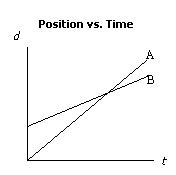 a. | Object B travels the greater distance. | b. | Object A has the greater
speed. | c. | Object A leaves the reference point at an earlier time. | d. | Both objects have
the same speed at the point where the lines cross. | e. | Object A is travelling for a longer period of
time. |
|
|
|
14.
|
The position-time graph pictured below represents a race between three
contestants A, B, and C. The race begins at time zero at the sound of the starter's pistol.
Which of the following statements is true? 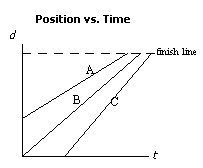 a. | The runner who started last finished first. | b. | The fastest runner
won the race. | c. | The runner with a head start won the race. | d. | Only one runner
began at the sound of the starter's pistol. | e. | All runners ran the same
distance. |
|
|
|
15.
|
The position-time graph pictured below depicts a person, P, running to catch a
bus, B, that has just begun to pull away. Which of the following statements is true? 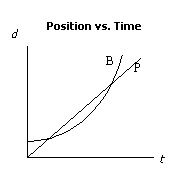 a. | The person has no chance of catching the bus. | b. | The person's
acceleration is greater than that of the bus. | c. | The person has two opportunities to catch up to
the bus. | d. | The speed of the bus is always greater than that of the person. | e. | The person's
speed is always greater than that of the bus. |
|
|
|
16.
|
The position-time graph that represents "uniform motion" is 
|
|
|
17.
|
Consider the following velocity-time graph and select the statement that is
true. 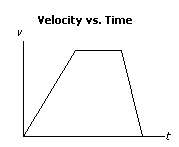 a. | At no time can the motion be considered "uniform." | b. | The object returns
to its original position. | c. | The object travels in one direction and then
the other. | d. | The object is accelerating throughout the entire recorded time. | e. | The object speeds up
and later slows down. |
|
|
|
18.
|
The following velocity-time graph depicts the motions of two objects, A and B.
Which of the statements describing the graph is true? 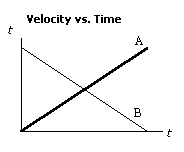 a. | Both objects are accelerating uniformly. | b. | The two objects are
travelling in opposite directions. | c. | Both objects start from
rest. | d. | Object A travels farther than object B. | e. | Object B travels
farther than object A. |
|
|
|
19.
|
Four of the five graphs pictured below could all represent the same motion.
Which graph does not belong to this group? 
|
|
|
20.
|
A pilot flies to a destination due north from the departure point. During the
flight there is a wind blowing from the west. What direction must the pilot point the plane during
the flight?
a. | due east | d. | due west | b. | east of north | e. | west of north | c. | due
north |
|
|
|
21.
|
A car drives 6.0 km [E], then 8.0 km [S] in a total time of
0.30 h. What is the car's average speed?
a. | 33 km/h | d. | 47 km/h [E of S] | b. | 47
km/h | e. | 47 km/h [S of
E] | c. | 33 km/h [E of S] |
|
|
|
22.
|
Over a period of 3.0 s a car's velocity changes from 18 m/s [W]
to 12 m/s [W]. What is the value of the car's acceleration during this time?
a. | 2.0 m/s2 [E] | d. | 10 m/s2
[E] | b. | 10 m/s2
[W] | e. | 2.0 m/s
[E] | c. | 2.0 m/s2 [W] |
|
|
|
23.
|
A car is driving along the highway behind a slower vehicle when it pulls out to
pass. If the car's acceleration is uniform at 2.0 m/s2 for 4.0 s and it reaches a
speed of 28 m/s, what was its speed when it first pulled out to pass the slower vehicle?
a. | 18 m/s | d. | 24 m/s | b. | 20 m/s | e. | 26 m/s | c. | 22
m/s |
|
|
|
24.
|
The position-time graph below depicts the motions of two objects, A and B. Which
of the following statements concerning the objects' motions is NOT true? 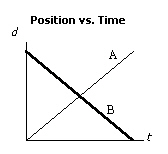 a. | The two objects have the same speed. | b. | The two objects travel the same
distance. | c. | The two objects travel with uniform motion. | d. | The two objects
travel for the same amount of time. | e. | The two objects have the same
velocity. |
|
|
|
25.
|
A bus drives 40.0 km [E] from town A to town B, then another 30.0 km
[S] to town C in a total time of 1.00 h. What are the values of its average speed and
average velocity, respectively?
a. | 70.0 km/h, 70.0 km/h [37º S of E] | d. | 50.0 km/h, 70.0 km/h [37º
S of E] | b. | 70.0 km/h, 50.0 km/h [37º S of E] | e. | 50.0 km/h [37º S of E], 70.0
km/h | c. | 50.0 km/h, 50.0 km/h [37º S of E] |
|
|
|
26.
|
The slope of a velocity-time graph represents
a. | displacement | d. | acceleration | b. | average velocity | e. | distance | c. | instantaneous
velocity |
|
|
|
27.
|
The area under an acceleration-time graph represents
a. | displacement | d. | instantaneous velocity | b. | change in
velocity | e. | average
speed | c. | average velocity |
|
|
|
28.
|
A boat always points directly at the opposite shore while crossing a river. The
time it will take to cross will be
a. | less if the current is stronger | b. | greater if the current is
stronger | c. | the same regardless of the current | d. | dependent on the strength of the
current | e. | impossible to predict without more information |
|
|
|
29.
|
To cross a river with a current in the least amount of time, a boat should
point
a. | directly at the opposite shore | b. | somewhat upstream | c. | somewhat
downstream | d. | in a direction that will take the boat directly across | e. | in a direction that
will take the boat slightly upstream |
|
|
|
30.
|
Three identical boats set out to cross a river that has a current. Boat A points
directly across the river, boat B points 20º downstream from a point straight across the river,
and boat C points 20º upstream from a point straight across the river. Which boat will arrive on
the opposite shore first?
a. | boat A | b. | boat B | c. | boat
C | d. | it is impossible to tell with the information given | e. | all three boats will
arrive at the same time |
|
|
|
31.
|
A football player successfully kicks a field goal through the uprights situated
at the south end of the stadium. What are the directions of the instantaneous velocity and
acceleration, respectively, of the football at the peak of its trajectory?
a. | south, south | d. | south, up | b. | up, south | e. | down, down | c. | south,
down |
|
|
|
32.
|
Which of the following graphs does NOT depict uniform motion?  a. | A and B | d. | B and D | b. | C only | e. | A and E | c. | D and
E |
|
|
|
33.
|
Which of the following descriptions best represents the acceleration-time graph
of a car that pulls away from a corner when the light turns green, reaches and maintains a constant
velocity, then slows down until it stops? Assume that all accelerations are uniform.
a. | All three sections of the graph are comprised of horizontal
lines. | b. | Two sections of the graph are diagonal lines and one is
horizontal. | c. | Two sections of the graph are horizontal lines and one is
diagonal. | d. | All three sections of the graph are comprised of diagonal lines. | e. | All three sections
of the graph are comprised of curved lines. |
|
|
|
34.
|
An object is thrown vertically upward with a speed of 25 m/s. How much time
passes before it comes back down at 15 m/s? (Air resistance is negligible.)
a. | 1.0 s | d. | 18 s | b. | 4.1 s | e. | 27 s | c. | 9.8
s |
|
|
|
35.
|
How long does it take a car to slow down from a speed of 54 km/h to 32 km/h over
a distance of 65 m? Answer in seconds.
|
|
|
36.
|
An object is travelling due east when it experiences a uniform acceleration
directed north. Its velocity some time later
a. | must be directed north | b. | could be directed north | c. | must be directed
north-east | d. | could be directed east when the acceleration ceases | e. | must be directed
east when the acceleration ceases |
|
|
|
37.
|
Ignoring air resistance, which of the following are exhibiting “free
fall”?
a. | an object, initially at rest, dropped out of a window | b. | an object thrown
vertically downward from a window | c. | an object projected vertically upward from a
window | d. | an object thrown horizontally from a window | e. | all of the
above |
|
|
|
38.
|
For a javelin thrower to maximize her throwing distance, she should release the
javelin at an angle
a. | of 45° | b. | of less than 45° | c. | of greater than 45° | d. | dependent on the javelin’s speed upon
release | e. | dependent on the thrower’s strength |
|
Completion
Complete each
statement.
|
|
|
39.
|
A toy car travels once around a circular track of radius 65 cm in a time of 2.8
s. The car’s average speed is ____________________ and the value of its average velocity is
____________________.
|
|
|
40.
|
An object is travelling with a velocity directed 30° W of N. If the object is slowing, its acceleration is directed
______________________.
|
|
|
41.
|
When analyzing any projectile problem, it is essential to be aware that the
horizontal component of the velocity is always ______________________________ and the vertical
component of the velocity is always ______________________________.
|
|
|
42.
|
A plane must fly due south to its destination. The pilot finds that he must
contend with a wind blowing from the west so he points the plane in a ____________________
direction.
|
Matching
|
|
|
Study the velocity-time graph pictured below and match each segment of the
graph with the description of its motion at that time.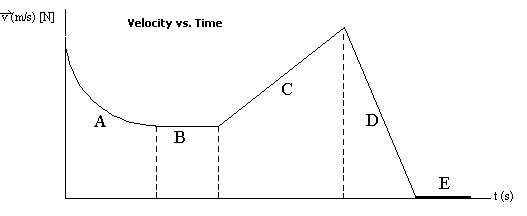 a. | segment A | d. | segment D | b. | segment B | e. | segment E | c. | segment
C |
|
|
|
43.
|
The object is motionless during this segment.
|
|
|
44.
|
The object is moving with constant velocity during this segment.
|
|
|
45.
|
The object travels the greatest distance during this segment.
|
|
|
46.
|
The object is experiencing non-uniform acceleration during this
segment.
|
|
|
47.
|
The object is travelling north but accelerating south during this
segment.
|
|
|
Match the item with the correct statement below. a. | change in velocity | c. | acceleration | b. | average velocity | d. | displacement |
|
|
|
48.
|
Found by taking the slope of a position-time graph.
|
|
|
49.
|
Found by taking the slope of a velocity-time graph.
|
|
|
50.
|
Found by taking the area under a velocity-time graph.
|
|
|
51.
|
Found by taking the area under an acceleration-time graph.
|
|
|
Match the calculation with the quantity it determines. a. | velocity | d. | displacement | b. | acceleration | e. | change in velocity | c. | jerk |
|
|
|
52.
|
the slope of a velocity-time graph
|
|
|
53.
|
the slope of an acceleration-time graph
|
|
|
54.
|
the slope of a position-time graph
|
|
|
55.
|
the area under an acceleration-time graph
|
|
|
56.
|
the area under a velocity-time graph
|
|
|
Three boats set out to cross a river that has a current. The speed of the
three boats relative to the water is the same. Boat A points at an angle of 30° upstream from a point directly across the river. Boat B points directly
across and boat C points 20° downstream from a point directly across
the river. Match the boat with the relative time it takes to cross.
|
|
|
57.
|
least time
|
|
|
58.
|
most time
|
|
|
59.
|
moderate time
|
|
|
Three stones are thrown from a cliff with the same speed but at different
angles of elevation above the horizontal. Match the angle of elevation with the relative horizontal
range for the stone. a. | maximum range | b. | minimum | c. | moderate
range |
|
|
|
60.
|
0°
|
|
|
61.
|
15°
|
|
|
62.
|
30°
|